Report: Sociological Context of Health and Social Care Issues
VerifiedAdded on 2020/01/23
|11
|3135
|106
Report
AI Summary
This report provides a comprehensive analysis of the sociological context of health and social care, focusing on the inequalities that exist within the system. It examines data from reports like the Black Report and Acheson Report to illustrate these inequalities, including disparities in mortality rates and access to resources. The report delves into sociological perspectives, analyzing how social inequalities impact individuals' health status and life chances, covering income, employment, and education. It further explores how social and health issues are socially constructed, using sociological concepts and theories such as functionalism, conflict theory, and symbolic interactionism to define health and well-being. The report also discusses the implications of these issues for health and social care service providers, highlighting the importance of addressing inequalities to improve overall health outcomes. The report concludes with a call for equitable treatment and behavior within the health and social care system.
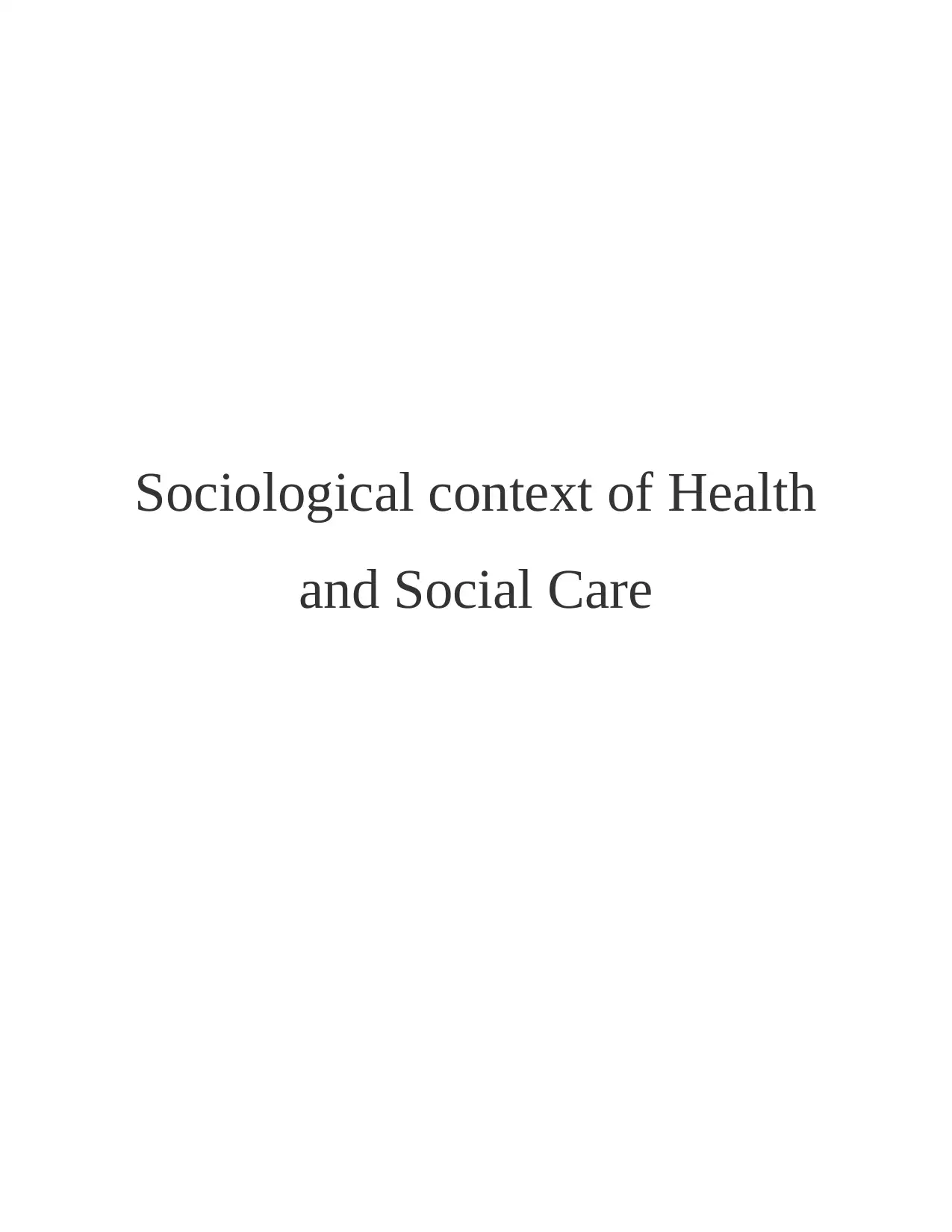
Sociological context of Health
and Social Care
and Social Care
Paraphrase This Document
Need a fresh take? Get an instant paraphrase of this document with our AI Paraphraser
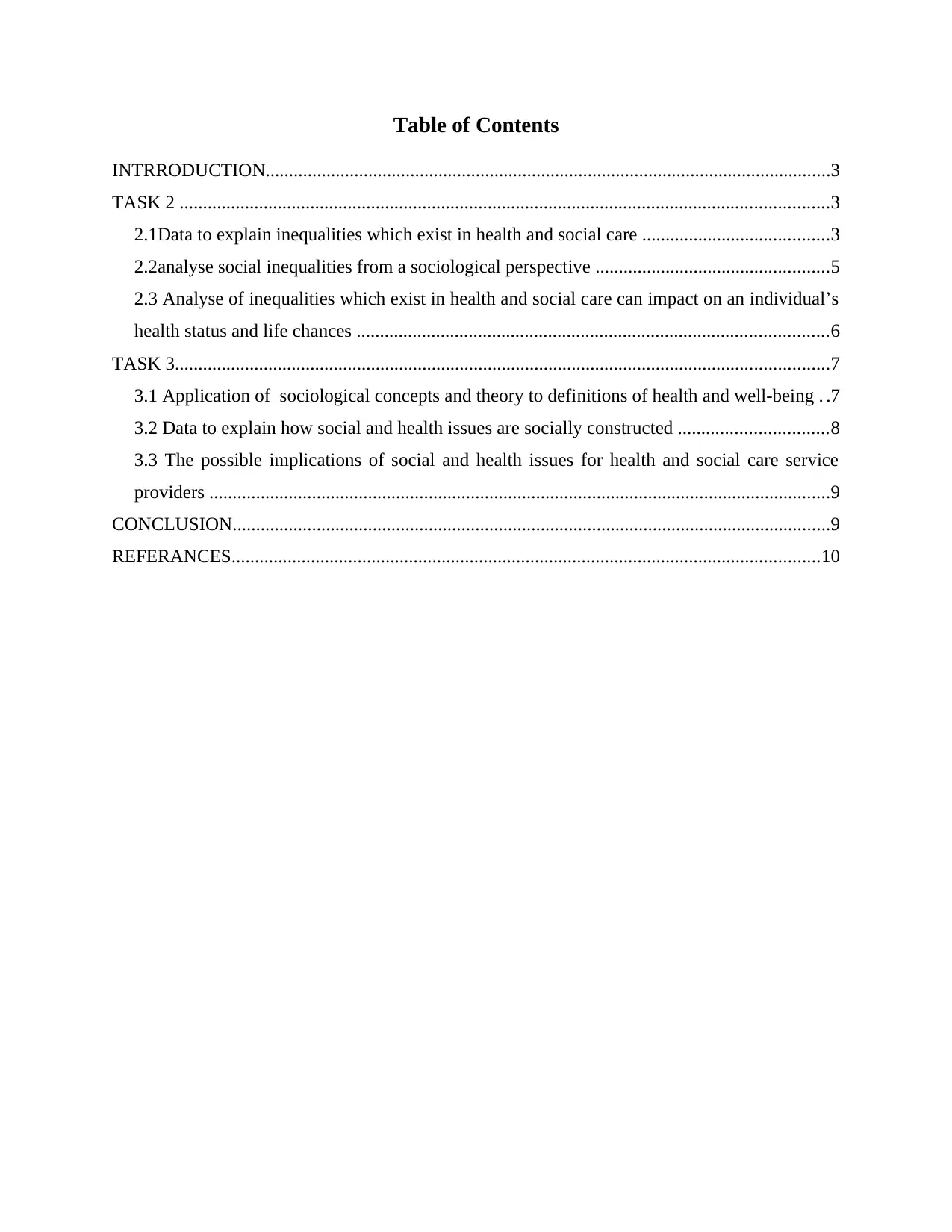
Table of Contents
INTRRODUCTION.........................................................................................................................3
TASK 2 ...........................................................................................................................................3
2.1Data to explain inequalities which exist in health and social care ........................................3
2.2analyse social inequalities from a sociological perspective ..................................................5
2.3 Analyse of inequalities which exist in health and social care can impact on an individual’s
health status and life chances .....................................................................................................6
TASK 3............................................................................................................................................7
3.1 Application of sociological concepts and theory to definitions of health and well-being . .7
3.2 Data to explain how social and health issues are socially constructed ................................8
3.3 The possible implications of social and health issues for health and social care service
providers .....................................................................................................................................9
CONCLUSION................................................................................................................................9
REFERANCES..............................................................................................................................10
INTRRODUCTION.........................................................................................................................3
TASK 2 ...........................................................................................................................................3
2.1Data to explain inequalities which exist in health and social care ........................................3
2.2analyse social inequalities from a sociological perspective ..................................................5
2.3 Analyse of inequalities which exist in health and social care can impact on an individual’s
health status and life chances .....................................................................................................6
TASK 3............................................................................................................................................7
3.1 Application of sociological concepts and theory to definitions of health and well-being . .7
3.2 Data to explain how social and health issues are socially constructed ................................8
3.3 The possible implications of social and health issues for health and social care service
providers .....................................................................................................................................9
CONCLUSION................................................................................................................................9
REFERANCES..............................................................................................................................10
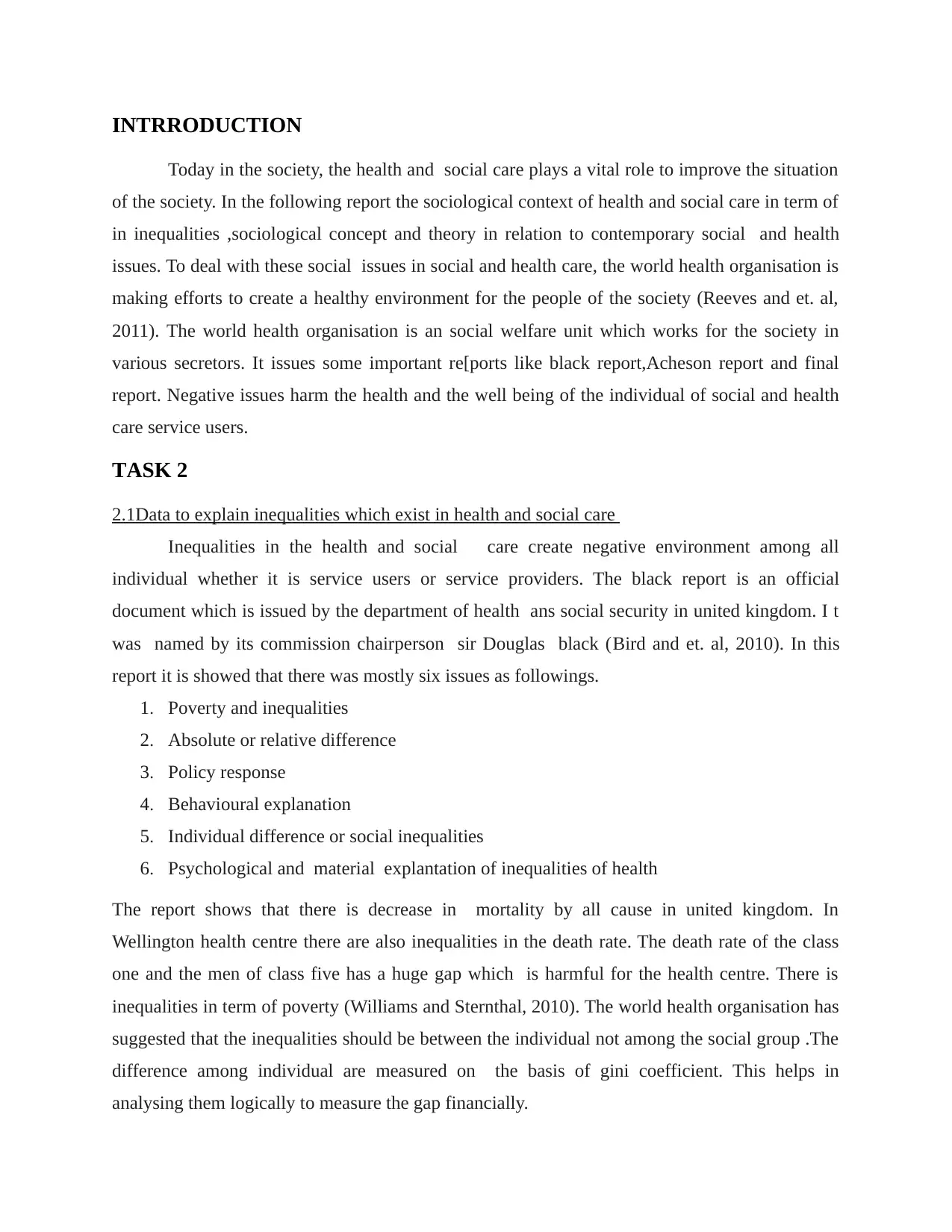
INTRRODUCTION
Today in the society, the health and social care plays a vital role to improve the situation
of the society. In the following report the sociological context of health and social care in term of
in inequalities ,sociological concept and theory in relation to contemporary social and health
issues. To deal with these social issues in social and health care, the world health organisation is
making efforts to create a healthy environment for the people of the society (Reeves and et. al,
2011). The world health organisation is an social welfare unit which works for the society in
various secretors. It issues some important re[ports like black report,Acheson report and final
report. Negative issues harm the health and the well being of the individual of social and health
care service users.
TASK 2
2.1Data to explain inequalities which exist in health and social care
Inequalities in the health and social care create negative environment among all
individual whether it is service users or service providers. The black report is an official
document which is issued by the department of health ans social security in united kingdom. I t
was named by its commission chairperson sir Douglas black (Bird and et. al, 2010). In this
report it is showed that there was mostly six issues as followings.
1. Poverty and inequalities
2. Absolute or relative difference
3. Policy response
4. Behavioural explanation
5. Individual difference or social inequalities
6. Psychological and material explantation of inequalities of health
The report shows that there is decrease in mortality by all cause in united kingdom. In
Wellington health centre there are also inequalities in the death rate. The death rate of the class
one and the men of class five has a huge gap which is harmful for the health centre. There is
inequalities in term of poverty (Williams and Sternthal, 2010). The world health organisation has
suggested that the inequalities should be between the individual not among the social group .The
difference among individual are measured on the basis of gini coefficient. This helps in
analysing them logically to measure the gap financially.
Today in the society, the health and social care plays a vital role to improve the situation
of the society. In the following report the sociological context of health and social care in term of
in inequalities ,sociological concept and theory in relation to contemporary social and health
issues. To deal with these social issues in social and health care, the world health organisation is
making efforts to create a healthy environment for the people of the society (Reeves and et. al,
2011). The world health organisation is an social welfare unit which works for the society in
various secretors. It issues some important re[ports like black report,Acheson report and final
report. Negative issues harm the health and the well being of the individual of social and health
care service users.
TASK 2
2.1Data to explain inequalities which exist in health and social care
Inequalities in the health and social care create negative environment among all
individual whether it is service users or service providers. The black report is an official
document which is issued by the department of health ans social security in united kingdom. I t
was named by its commission chairperson sir Douglas black (Bird and et. al, 2010). In this
report it is showed that there was mostly six issues as followings.
1. Poverty and inequalities
2. Absolute or relative difference
3. Policy response
4. Behavioural explanation
5. Individual difference or social inequalities
6. Psychological and material explantation of inequalities of health
The report shows that there is decrease in mortality by all cause in united kingdom. In
Wellington health centre there are also inequalities in the death rate. The death rate of the class
one and the men of class five has a huge gap which is harmful for the health centre. There is
inequalities in term of poverty (Williams and Sternthal, 2010). The world health organisation has
suggested that the inequalities should be between the individual not among the social group .The
difference among individual are measured on the basis of gini coefficient. This helps in
analysing them logically to measure the gap financially.
⊘ This is a preview!⊘
Do you want full access?
Subscribe today to unlock all pages.

Trusted by 1+ million students worldwide
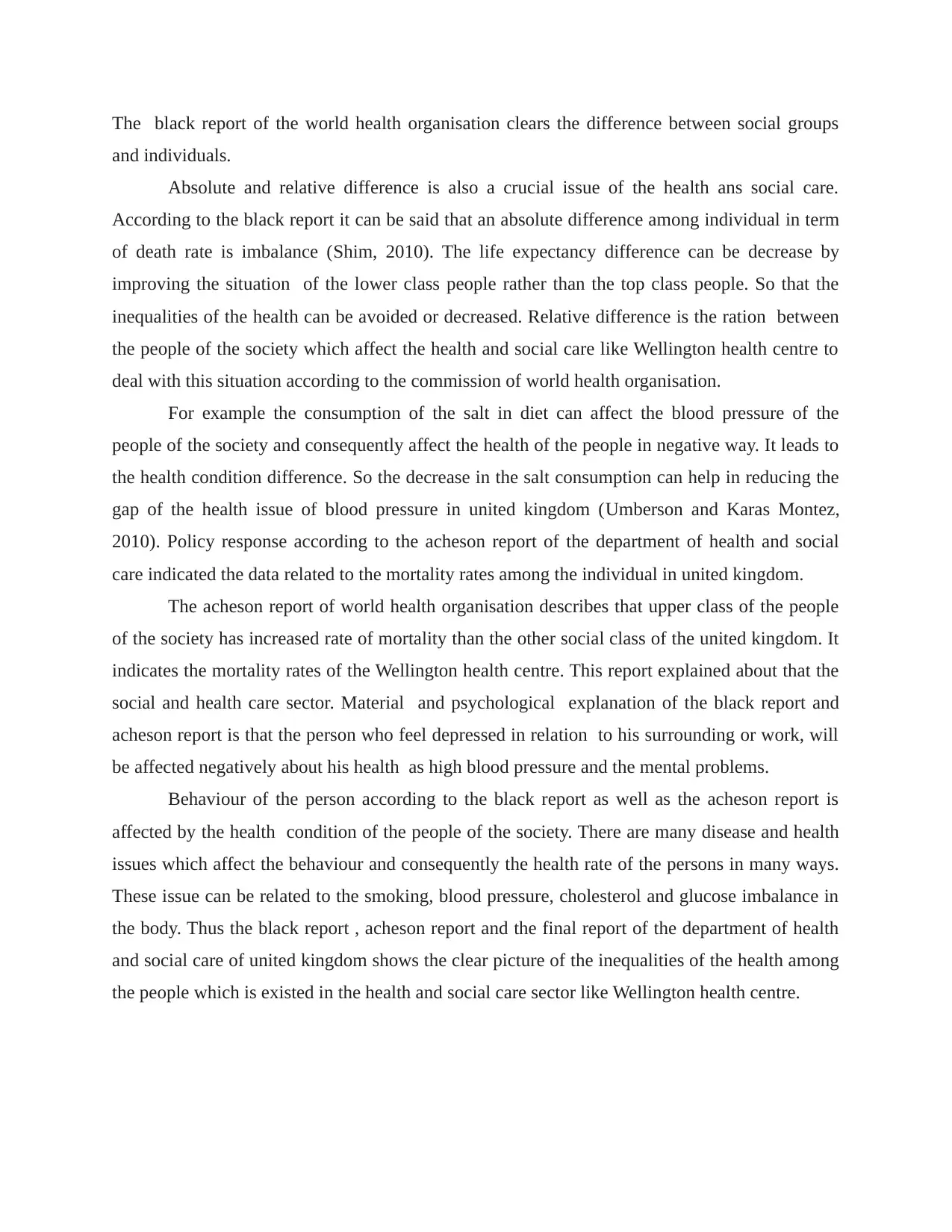
The black report of the world health organisation clears the difference between social groups
and individuals.
Absolute and relative difference is also a crucial issue of the health ans social care.
According to the black report it can be said that an absolute difference among individual in term
of death rate is imbalance (Shim, 2010). The life expectancy difference can be decrease by
improving the situation of the lower class people rather than the top class people. So that the
inequalities of the health can be avoided or decreased. Relative difference is the ration between
the people of the society which affect the health and social care like Wellington health centre to
deal with this situation according to the commission of world health organisation.
For example the consumption of the salt in diet can affect the blood pressure of the
people of the society and consequently affect the health of the people in negative way. It leads to
the health condition difference. So the decrease in the salt consumption can help in reducing the
gap of the health issue of blood pressure in united kingdom (Umberson and Karas Montez,
2010). Policy response according to the acheson report of the department of health and social
care indicated the data related to the mortality rates among the individual in united kingdom.
The acheson report of world health organisation describes that upper class of the people
of the society has increased rate of mortality than the other social class of the united kingdom. It
indicates the mortality rates of the Wellington health centre. This report explained about that the
social and health care sector. Material and psychological explanation of the black report and
acheson report is that the person who feel depressed in relation to his surrounding or work, will
be affected negatively about his health as high blood pressure and the mental problems.
Behaviour of the person according to the black report as well as the acheson report is
affected by the health condition of the people of the society. There are many disease and health
issues which affect the behaviour and consequently the health rate of the persons in many ways.
These issue can be related to the smoking, blood pressure, cholesterol and glucose imbalance in
the body. Thus the black report , acheson report and the final report of the department of health
and social care of united kingdom shows the clear picture of the inequalities of the health among
the people which is existed in the health and social care sector like Wellington health centre.
and individuals.
Absolute and relative difference is also a crucial issue of the health ans social care.
According to the black report it can be said that an absolute difference among individual in term
of death rate is imbalance (Shim, 2010). The life expectancy difference can be decrease by
improving the situation of the lower class people rather than the top class people. So that the
inequalities of the health can be avoided or decreased. Relative difference is the ration between
the people of the society which affect the health and social care like Wellington health centre to
deal with this situation according to the commission of world health organisation.
For example the consumption of the salt in diet can affect the blood pressure of the
people of the society and consequently affect the health of the people in negative way. It leads to
the health condition difference. So the decrease in the salt consumption can help in reducing the
gap of the health issue of blood pressure in united kingdom (Umberson and Karas Montez,
2010). Policy response according to the acheson report of the department of health and social
care indicated the data related to the mortality rates among the individual in united kingdom.
The acheson report of world health organisation describes that upper class of the people
of the society has increased rate of mortality than the other social class of the united kingdom. It
indicates the mortality rates of the Wellington health centre. This report explained about that the
social and health care sector. Material and psychological explanation of the black report and
acheson report is that the person who feel depressed in relation to his surrounding or work, will
be affected negatively about his health as high blood pressure and the mental problems.
Behaviour of the person according to the black report as well as the acheson report is
affected by the health condition of the people of the society. There are many disease and health
issues which affect the behaviour and consequently the health rate of the persons in many ways.
These issue can be related to the smoking, blood pressure, cholesterol and glucose imbalance in
the body. Thus the black report , acheson report and the final report of the department of health
and social care of united kingdom shows the clear picture of the inequalities of the health among
the people which is existed in the health and social care sector like Wellington health centre.
Paraphrase This Document
Need a fresh take? Get an instant paraphrase of this document with our AI Paraphraser
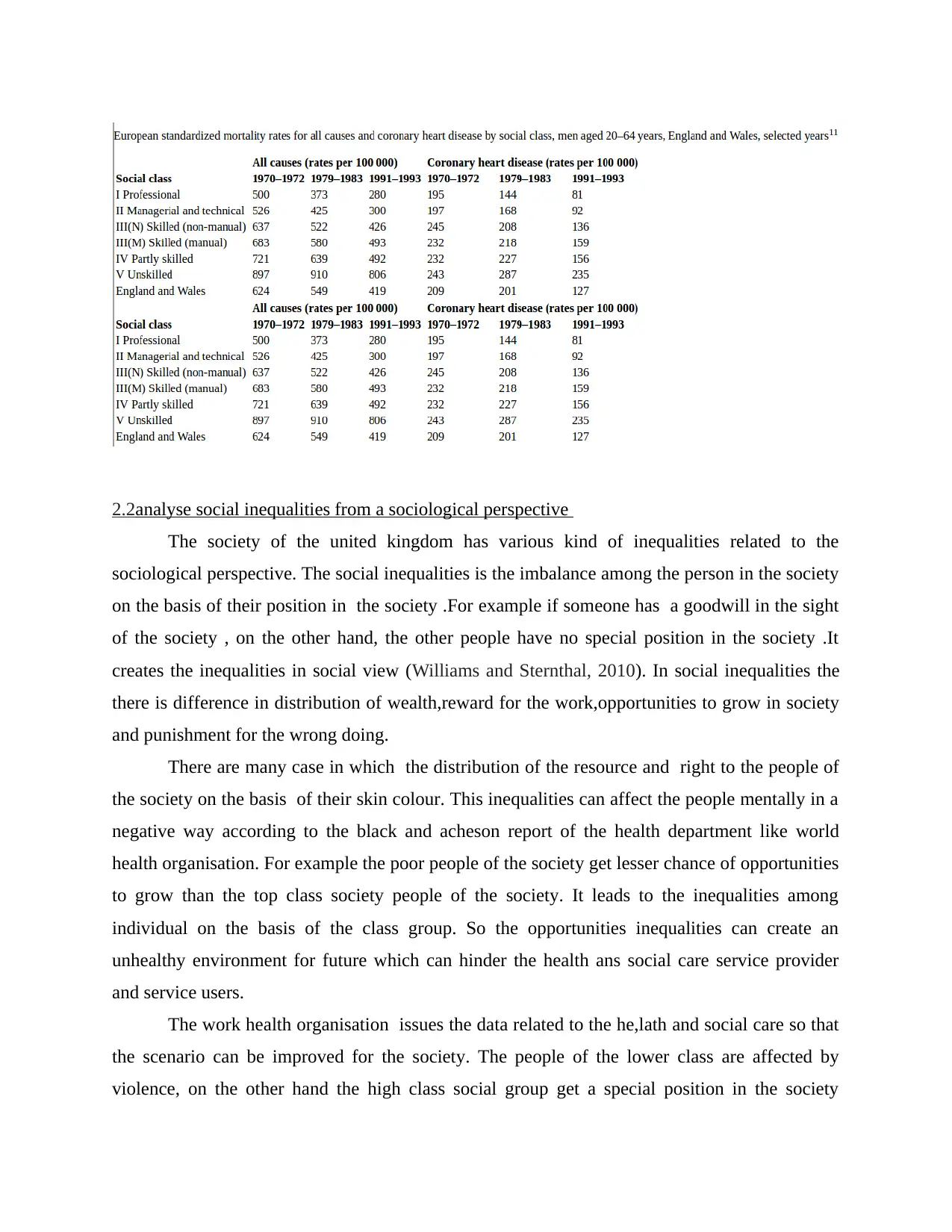
2.2analyse social inequalities from a sociological perspective
The society of the united kingdom has various kind of inequalities related to the
sociological perspective. The social inequalities is the imbalance among the person in the society
on the basis of their position in the society .For example if someone has a goodwill in the sight
of the society , on the other hand, the other people have no special position in the society .It
creates the inequalities in social view (Williams and Sternthal, 2010). In social inequalities the
there is difference in distribution of wealth,reward for the work,opportunities to grow in society
and punishment for the wrong doing.
There are many case in which the distribution of the resource and right to the people of
the society on the basis of their skin colour. This inequalities can affect the people mentally in a
negative way according to the black and acheson report of the health department like world
health organisation. For example the poor people of the society get lesser chance of opportunities
to grow than the top class society people of the society. It leads to the inequalities among
individual on the basis of the class group. So the opportunities inequalities can create an
unhealthy environment for future which can hinder the health ans social care service provider
and service users.
The work health organisation issues the data related to the he,lath and social care so that
the scenario can be improved for the society. The people of the lower class are affected by
violence, on the other hand the high class social group get a special position in the society
The society of the united kingdom has various kind of inequalities related to the
sociological perspective. The social inequalities is the imbalance among the person in the society
on the basis of their position in the society .For example if someone has a goodwill in the sight
of the society , on the other hand, the other people have no special position in the society .It
creates the inequalities in social view (Williams and Sternthal, 2010). In social inequalities the
there is difference in distribution of wealth,reward for the work,opportunities to grow in society
and punishment for the wrong doing.
There are many case in which the distribution of the resource and right to the people of
the society on the basis of their skin colour. This inequalities can affect the people mentally in a
negative way according to the black and acheson report of the health department like world
health organisation. For example the poor people of the society get lesser chance of opportunities
to grow than the top class society people of the society. It leads to the inequalities among
individual on the basis of the class group. So the opportunities inequalities can create an
unhealthy environment for future which can hinder the health ans social care service provider
and service users.
The work health organisation issues the data related to the he,lath and social care so that
the scenario can be improved for the society. The people of the lower class are affected by
violence, on the other hand the high class social group get a special position in the society
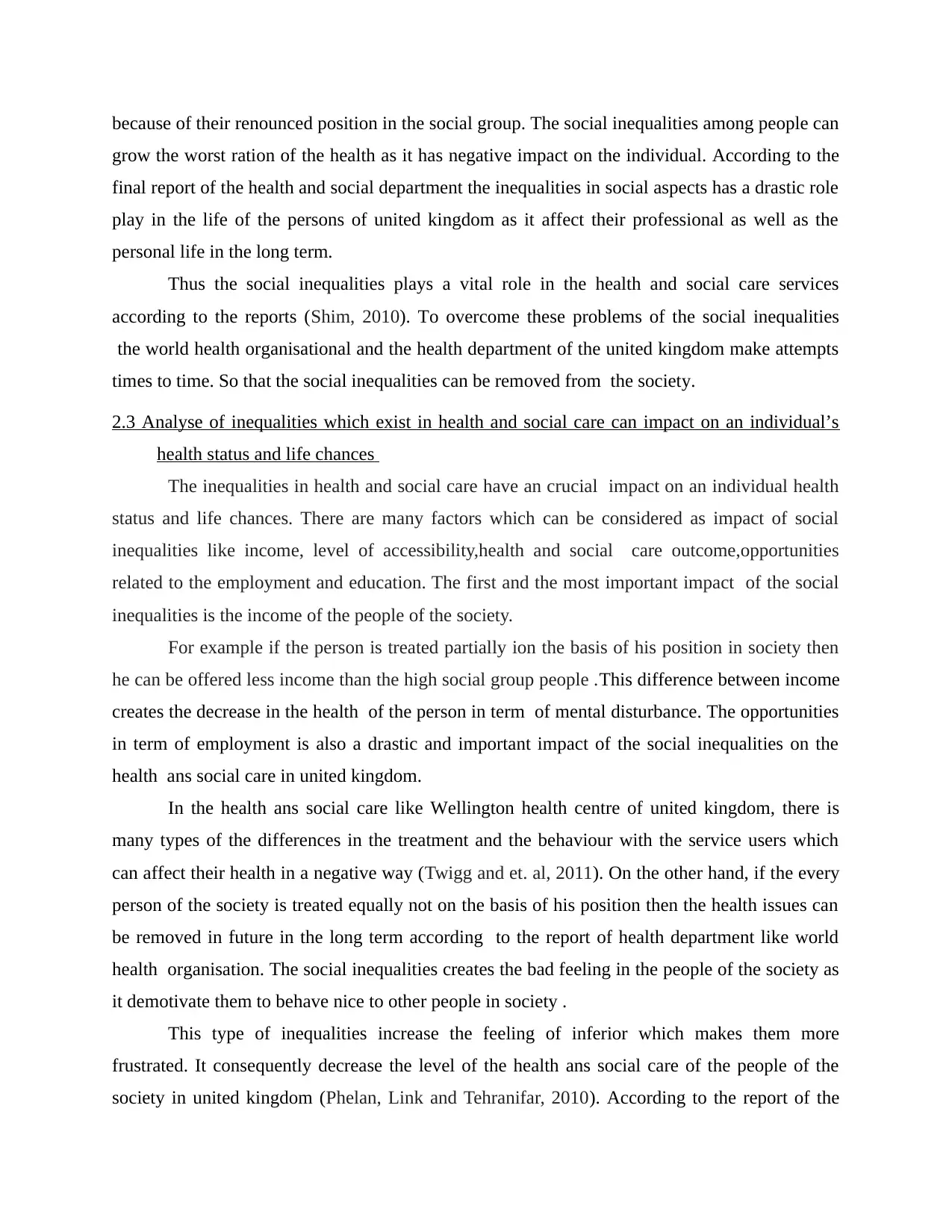
because of their renounced position in the social group. The social inequalities among people can
grow the worst ration of the health as it has negative impact on the individual. According to the
final report of the health and social department the inequalities in social aspects has a drastic role
play in the life of the persons of united kingdom as it affect their professional as well as the
personal life in the long term.
Thus the social inequalities plays a vital role in the health and social care services
according to the reports (Shim, 2010). To overcome these problems of the social inequalities
the world health organisational and the health department of the united kingdom make attempts
times to time. So that the social inequalities can be removed from the society.
2.3 Analyse of inequalities which exist in health and social care can impact on an individual’s
health status and life chances
The inequalities in health and social care have an crucial impact on an individual health
status and life chances. There are many factors which can be considered as impact of social
inequalities like income, level of accessibility,health and social care outcome,opportunities
related to the employment and education. The first and the most important impact of the social
inequalities is the income of the people of the society.
For example if the person is treated partially ion the basis of his position in society then
he can be offered less income than the high social group people .This difference between income
creates the decrease in the health of the person in term of mental disturbance. The opportunities
in term of employment is also a drastic and important impact of the social inequalities on the
health ans social care in united kingdom.
In the health ans social care like Wellington health centre of united kingdom, there is
many types of the differences in the treatment and the behaviour with the service users which
can affect their health in a negative way (Twigg and et. al, 2011). On the other hand, if the every
person of the society is treated equally not on the basis of his position then the health issues can
be removed in future in the long term according to the report of health department like world
health organisation. The social inequalities creates the bad feeling in the people of the society as
it demotivate them to behave nice to other people in society .
This type of inequalities increase the feeling of inferior which makes them more
frustrated. It consequently decrease the level of the health ans social care of the people of the
society in united kingdom (Phelan, Link and Tehranifar, 2010). According to the report of the
grow the worst ration of the health as it has negative impact on the individual. According to the
final report of the health and social department the inequalities in social aspects has a drastic role
play in the life of the persons of united kingdom as it affect their professional as well as the
personal life in the long term.
Thus the social inequalities plays a vital role in the health and social care services
according to the reports (Shim, 2010). To overcome these problems of the social inequalities
the world health organisational and the health department of the united kingdom make attempts
times to time. So that the social inequalities can be removed from the society.
2.3 Analyse of inequalities which exist in health and social care can impact on an individual’s
health status and life chances
The inequalities in health and social care have an crucial impact on an individual health
status and life chances. There are many factors which can be considered as impact of social
inequalities like income, level of accessibility,health and social care outcome,opportunities
related to the employment and education. The first and the most important impact of the social
inequalities is the income of the people of the society.
For example if the person is treated partially ion the basis of his position in society then
he can be offered less income than the high social group people .This difference between income
creates the decrease in the health of the person in term of mental disturbance. The opportunities
in term of employment is also a drastic and important impact of the social inequalities on the
health ans social care in united kingdom.
In the health ans social care like Wellington health centre of united kingdom, there is
many types of the differences in the treatment and the behaviour with the service users which
can affect their health in a negative way (Twigg and et. al, 2011). On the other hand, if the every
person of the society is treated equally not on the basis of his position then the health issues can
be removed in future in the long term according to the report of health department like world
health organisation. The social inequalities creates the bad feeling in the people of the society as
it demotivate them to behave nice to other people in society .
This type of inequalities increase the feeling of inferior which makes them more
frustrated. It consequently decrease the level of the health ans social care of the people of the
society in united kingdom (Phelan, Link and Tehranifar, 2010). According to the report of the
⊘ This is a preview!⊘
Do you want full access?
Subscribe today to unlock all pages.

Trusted by 1+ million students worldwide
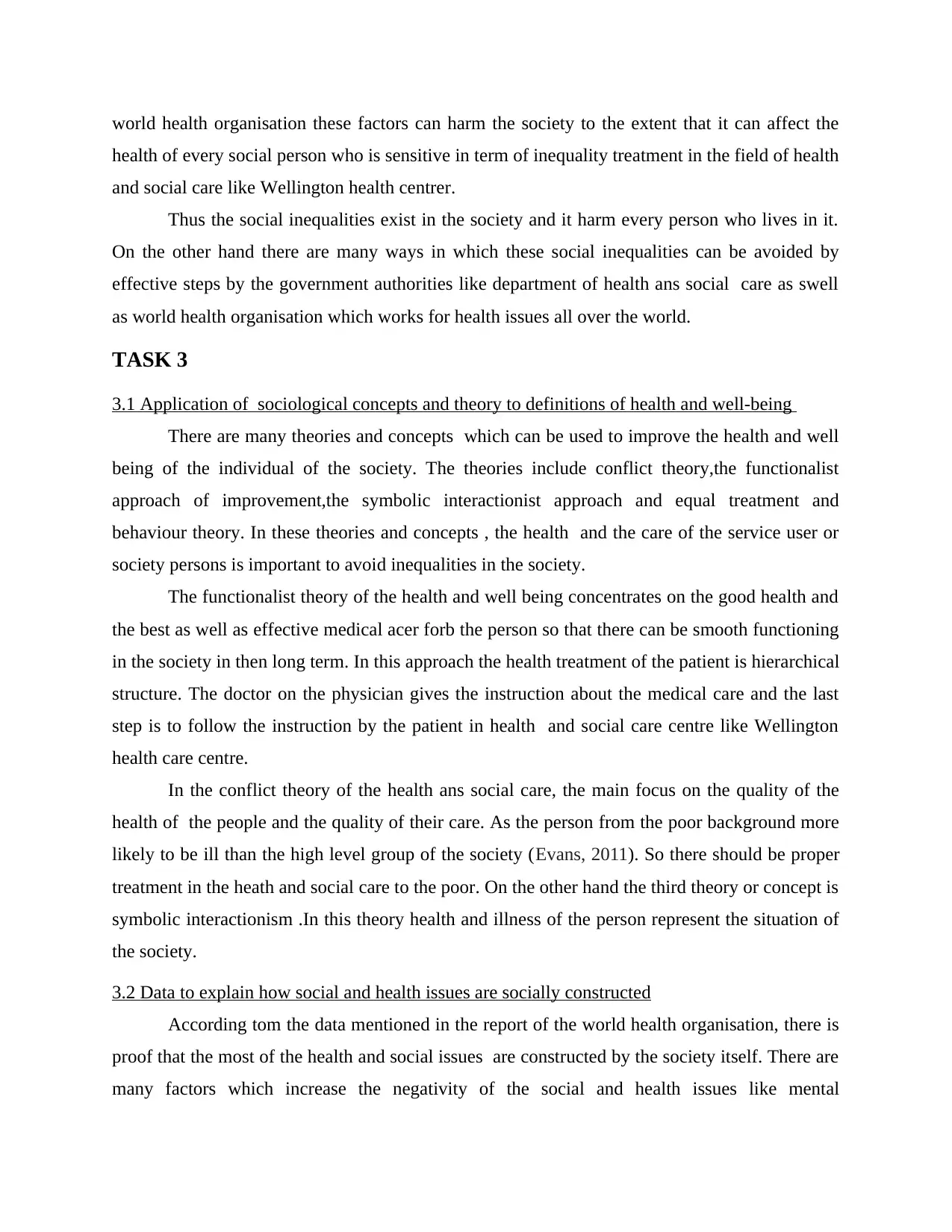
world health organisation these factors can harm the society to the extent that it can affect the
health of every social person who is sensitive in term of inequality treatment in the field of health
and social care like Wellington health centrer.
Thus the social inequalities exist in the society and it harm every person who lives in it.
On the other hand there are many ways in which these social inequalities can be avoided by
effective steps by the government authorities like department of health ans social care as swell
as world health organisation which works for health issues all over the world.
TASK 3
3.1 Application of sociological concepts and theory to definitions of health and well-being
There are many theories and concepts which can be used to improve the health and well
being of the individual of the society. The theories include conflict theory,the functionalist
approach of improvement,the symbolic interactionist approach and equal treatment and
behaviour theory. In these theories and concepts , the health and the care of the service user or
society persons is important to avoid inequalities in the society.
The functionalist theory of the health and well being concentrates on the good health and
the best as well as effective medical acer forb the person so that there can be smooth functioning
in the society in then long term. In this approach the health treatment of the patient is hierarchical
structure. The doctor on the physician gives the instruction about the medical care and the last
step is to follow the instruction by the patient in health and social care centre like Wellington
health care centre.
In the conflict theory of the health ans social care, the main focus on the quality of the
health of the people and the quality of their care. As the person from the poor background more
likely to be ill than the high level group of the society (Evans, 2011). So there should be proper
treatment in the heath and social care to the poor. On the other hand the third theory or concept is
symbolic interactionism .In this theory health and illness of the person represent the situation of
the society.
3.2 Data to explain how social and health issues are socially constructed
According tom the data mentioned in the report of the world health organisation, there is
proof that the most of the health and social issues are constructed by the society itself. There are
many factors which increase the negativity of the social and health issues like mental
health of every social person who is sensitive in term of inequality treatment in the field of health
and social care like Wellington health centrer.
Thus the social inequalities exist in the society and it harm every person who lives in it.
On the other hand there are many ways in which these social inequalities can be avoided by
effective steps by the government authorities like department of health ans social care as swell
as world health organisation which works for health issues all over the world.
TASK 3
3.1 Application of sociological concepts and theory to definitions of health and well-being
There are many theories and concepts which can be used to improve the health and well
being of the individual of the society. The theories include conflict theory,the functionalist
approach of improvement,the symbolic interactionist approach and equal treatment and
behaviour theory. In these theories and concepts , the health and the care of the service user or
society persons is important to avoid inequalities in the society.
The functionalist theory of the health and well being concentrates on the good health and
the best as well as effective medical acer forb the person so that there can be smooth functioning
in the society in then long term. In this approach the health treatment of the patient is hierarchical
structure. The doctor on the physician gives the instruction about the medical care and the last
step is to follow the instruction by the patient in health and social care centre like Wellington
health care centre.
In the conflict theory of the health ans social care, the main focus on the quality of the
health of the people and the quality of their care. As the person from the poor background more
likely to be ill than the high level group of the society (Evans, 2011). So there should be proper
treatment in the heath and social care to the poor. On the other hand the third theory or concept is
symbolic interactionism .In this theory health and illness of the person represent the situation of
the society.
3.2 Data to explain how social and health issues are socially constructed
According tom the data mentioned in the report of the world health organisation, there is
proof that the most of the health and social issues are constructed by the society itself. There are
many factors which increase the negativity of the social and health issues like mental
Paraphrase This Document
Need a fresh take? Get an instant paraphrase of this document with our AI Paraphraser
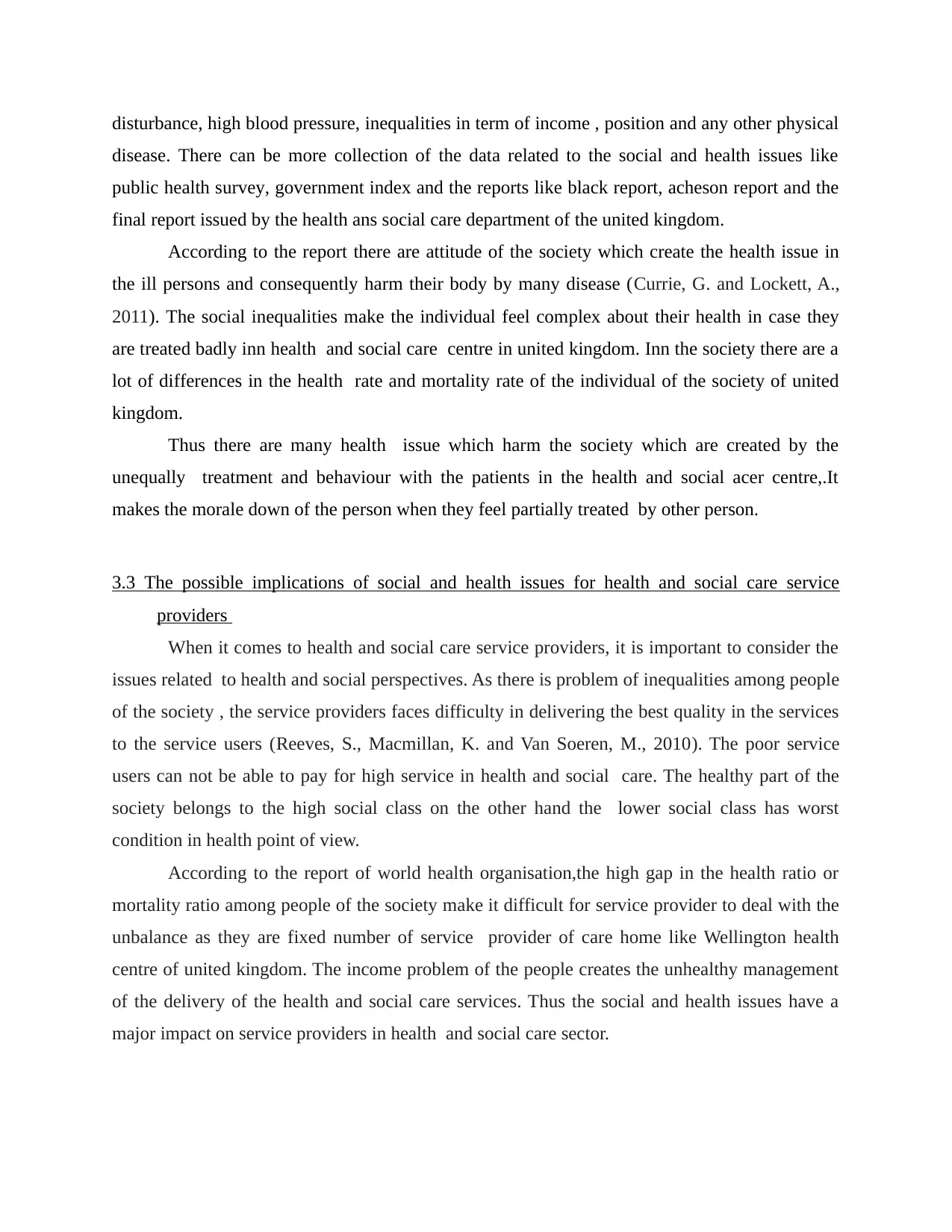
disturbance, high blood pressure, inequalities in term of income , position and any other physical
disease. There can be more collection of the data related to the social and health issues like
public health survey, government index and the reports like black report, acheson report and the
final report issued by the health ans social care department of the united kingdom.
According to the report there are attitude of the society which create the health issue in
the ill persons and consequently harm their body by many disease (Currie, G. and Lockett, A.,
2011). The social inequalities make the individual feel complex about their health in case they
are treated badly inn health and social care centre in united kingdom. Inn the society there are a
lot of differences in the health rate and mortality rate of the individual of the society of united
kingdom.
Thus there are many health issue which harm the society which are created by the
unequally treatment and behaviour with the patients in the health and social acer centre,.It
makes the morale down of the person when they feel partially treated by other person.
3.3 The possible implications of social and health issues for health and social care service
providers
When it comes to health and social care service providers, it is important to consider the
issues related to health and social perspectives. As there is problem of inequalities among people
of the society , the service providers faces difficulty in delivering the best quality in the services
to the service users (Reeves, S., Macmillan, K. and Van Soeren, M., 2010). The poor service
users can not be able to pay for high service in health and social care. The healthy part of the
society belongs to the high social class on the other hand the lower social class has worst
condition in health point of view.
According to the report of world health organisation,the high gap in the health ratio or
mortality ratio among people of the society make it difficult for service provider to deal with the
unbalance as they are fixed number of service provider of care home like Wellington health
centre of united kingdom. The income problem of the people creates the unhealthy management
of the delivery of the health and social care services. Thus the social and health issues have a
major impact on service providers in health and social care sector.
disease. There can be more collection of the data related to the social and health issues like
public health survey, government index and the reports like black report, acheson report and the
final report issued by the health ans social care department of the united kingdom.
According to the report there are attitude of the society which create the health issue in
the ill persons and consequently harm their body by many disease (Currie, G. and Lockett, A.,
2011). The social inequalities make the individual feel complex about their health in case they
are treated badly inn health and social care centre in united kingdom. Inn the society there are a
lot of differences in the health rate and mortality rate of the individual of the society of united
kingdom.
Thus there are many health issue which harm the society which are created by the
unequally treatment and behaviour with the patients in the health and social acer centre,.It
makes the morale down of the person when they feel partially treated by other person.
3.3 The possible implications of social and health issues for health and social care service
providers
When it comes to health and social care service providers, it is important to consider the
issues related to health and social perspectives. As there is problem of inequalities among people
of the society , the service providers faces difficulty in delivering the best quality in the services
to the service users (Reeves, S., Macmillan, K. and Van Soeren, M., 2010). The poor service
users can not be able to pay for high service in health and social care. The healthy part of the
society belongs to the high social class on the other hand the lower social class has worst
condition in health point of view.
According to the report of world health organisation,the high gap in the health ratio or
mortality ratio among people of the society make it difficult for service provider to deal with the
unbalance as they are fixed number of service provider of care home like Wellington health
centre of united kingdom. The income problem of the people creates the unhealthy management
of the delivery of the health and social care services. Thus the social and health issues have a
major impact on service providers in health and social care sector.
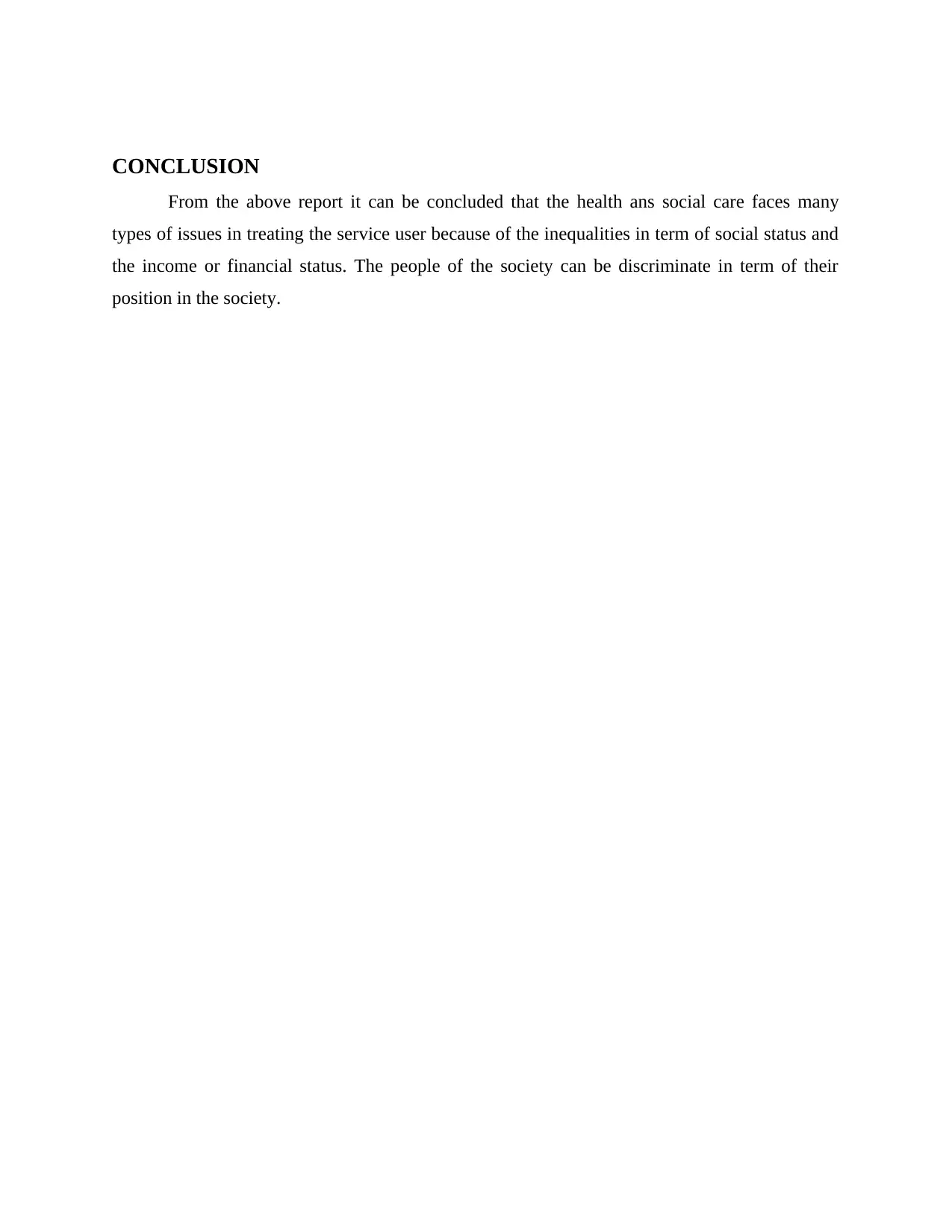
CONCLUSION
From the above report it can be concluded that the health ans social care faces many
types of issues in treating the service user because of the inequalities in term of social status and
the income or financial status. The people of the society can be discriminate in term of their
position in the society.
From the above report it can be concluded that the health ans social care faces many
types of issues in treating the service user because of the inequalities in term of social status and
the income or financial status. The people of the society can be discriminate in term of their
position in the society.
⊘ This is a preview!⊘
Do you want full access?
Subscribe today to unlock all pages.

Trusted by 1+ million students worldwide
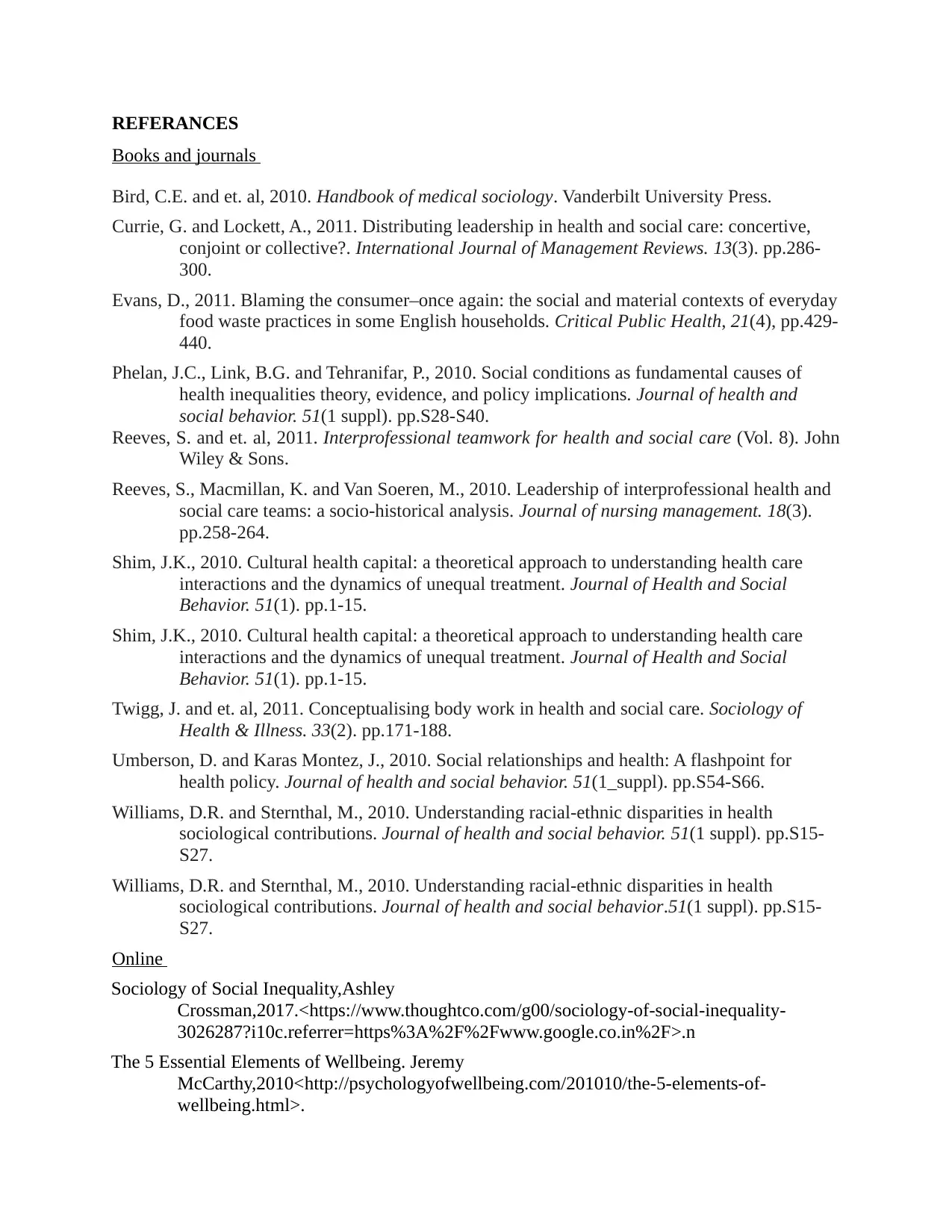
REFERANCES
Books and journals
Bird, C.E. and et. al, 2010. Handbook of medical sociology. Vanderbilt University Press.
Currie, G. and Lockett, A., 2011. Distributing leadership in health and social care: concertive,
conjoint or collective?. International Journal of Management Reviews. 13(3). pp.286-
300.
Evans, D., 2011. Blaming the consumer–once again: the social and material contexts of everyday
food waste practices in some English households. Critical Public Health, 21(4), pp.429-
440.
Phelan, J.C., Link, B.G. and Tehranifar, P., 2010. Social conditions as fundamental causes of
health inequalities theory, evidence, and policy implications. Journal of health and
social behavior. 51(1 suppl). pp.S28-S40.
Reeves, S. and et. al, 2011. Interprofessional teamwork for health and social care (Vol. 8). John
Wiley & Sons.
Reeves, S., Macmillan, K. and Van Soeren, M., 2010. Leadership of interprofessional health and
social care teams: a socio‐historical analysis. Journal of nursing management. 18(3).
pp.258-264.
Shim, J.K., 2010. Cultural health capital: a theoretical approach to understanding health care
interactions and the dynamics of unequal treatment. Journal of Health and Social
Behavior. 51(1). pp.1-15.
Shim, J.K., 2010. Cultural health capital: a theoretical approach to understanding health care
interactions and the dynamics of unequal treatment. Journal of Health and Social
Behavior. 51(1). pp.1-15.
Twigg, J. and et. al, 2011. Conceptualising body work in health and social care. Sociology of
Health & Illness. 33(2). pp.171-188.
Umberson, D. and Karas Montez, J., 2010. Social relationships and health: A flashpoint for
health policy. Journal of health and social behavior. 51(1_suppl). pp.S54-S66.
Williams, D.R. and Sternthal, M., 2010. Understanding racial-ethnic disparities in health
sociological contributions. Journal of health and social behavior. 51(1 suppl). pp.S15-
S27.
Williams, D.R. and Sternthal, M., 2010. Understanding racial-ethnic disparities in health
sociological contributions. Journal of health and social behavior.51(1 suppl). pp.S15-
S27.
Online
Sociology of Social Inequality,Ashley
Crossman,2017.<https://www.thoughtco.com/g00/sociology-of-social-inequality-
3026287?i10c.referrer=https%3A%2F%2Fwww.google.co.in%2F>.n
The 5 Essential Elements of Wellbeing. Jeremy
McCarthy,2010<http://psychologyofwellbeing.com/201010/the-5-elements-of-
wellbeing.html>.
Books and journals
Bird, C.E. and et. al, 2010. Handbook of medical sociology. Vanderbilt University Press.
Currie, G. and Lockett, A., 2011. Distributing leadership in health and social care: concertive,
conjoint or collective?. International Journal of Management Reviews. 13(3). pp.286-
300.
Evans, D., 2011. Blaming the consumer–once again: the social and material contexts of everyday
food waste practices in some English households. Critical Public Health, 21(4), pp.429-
440.
Phelan, J.C., Link, B.G. and Tehranifar, P., 2010. Social conditions as fundamental causes of
health inequalities theory, evidence, and policy implications. Journal of health and
social behavior. 51(1 suppl). pp.S28-S40.
Reeves, S. and et. al, 2011. Interprofessional teamwork for health and social care (Vol. 8). John
Wiley & Sons.
Reeves, S., Macmillan, K. and Van Soeren, M., 2010. Leadership of interprofessional health and
social care teams: a socio‐historical analysis. Journal of nursing management. 18(3).
pp.258-264.
Shim, J.K., 2010. Cultural health capital: a theoretical approach to understanding health care
interactions and the dynamics of unequal treatment. Journal of Health and Social
Behavior. 51(1). pp.1-15.
Shim, J.K., 2010. Cultural health capital: a theoretical approach to understanding health care
interactions and the dynamics of unequal treatment. Journal of Health and Social
Behavior. 51(1). pp.1-15.
Twigg, J. and et. al, 2011. Conceptualising body work in health and social care. Sociology of
Health & Illness. 33(2). pp.171-188.
Umberson, D. and Karas Montez, J., 2010. Social relationships and health: A flashpoint for
health policy. Journal of health and social behavior. 51(1_suppl). pp.S54-S66.
Williams, D.R. and Sternthal, M., 2010. Understanding racial-ethnic disparities in health
sociological contributions. Journal of health and social behavior. 51(1 suppl). pp.S15-
S27.
Williams, D.R. and Sternthal, M., 2010. Understanding racial-ethnic disparities in health
sociological contributions. Journal of health and social behavior.51(1 suppl). pp.S15-
S27.
Online
Sociology of Social Inequality,Ashley
Crossman,2017.<https://www.thoughtco.com/g00/sociology-of-social-inequality-
3026287?i10c.referrer=https%3A%2F%2Fwww.google.co.in%2F>.n
The 5 Essential Elements of Wellbeing. Jeremy
McCarthy,2010<http://psychologyofwellbeing.com/201010/the-5-elements-of-
wellbeing.html>.
Paraphrase This Document
Need a fresh take? Get an instant paraphrase of this document with our AI Paraphraser

1 out of 11
Related Documents
Your All-in-One AI-Powered Toolkit for Academic Success.
+13062052269
info@desklib.com
Available 24*7 on WhatsApp / Email
![[object Object]](/_next/static/media/star-bottom.7253800d.svg)
Unlock your academic potential
Copyright © 2020–2025 A2Z Services. All Rights Reserved. Developed and managed by ZUCOL.





